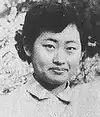Michiko Kanba
Michiko Kanba (樺 美智子, Kanba Michiko, November 8, 1937 – June 15, 1960) was a University of Tokyo undergraduate and a Zengakuren activist. She died in clashes between demonstrators and police at the South Gate of the National Diet Building in central Tokyo at the climax of the 1960 Anpo Protests against the US-Japan Security Treaty. She is buried in Tama Cemetery in Tokyo.[1]
Michiko Kanba | |
|---|---|
樺 美智子 | |
 | |
| Born | November 8, 1937 |
| Died | June 15, 1960 (aged 22) South Gate of the National Diet Building |
| Cause of death | Police clash |
| Burial place | Tama Cemetery |
| Known for | The Smile Nobody Knows |
| Parent(s) |
|
Activism and writing
Michiko Kanba was born in Tokyo. Her father was Toshio Kanba, a sociologist and professor at Chuo University.[2]
Kanba was raised in a middle-class Christian household, and entered University of Tokyo in 1957 and joined the Japan Communist Party on November of that year. After that, she became a leader in the New Left organization Bund and participated in mass demonstrations against the revisions of the Treaty of Mutual Cooperation and Security Between the United States and Japan.[3]
Kanba was one of the 76 student activists who were arrested at a January 26, 1960 sit-in at Haneda Airport.[4] She also participated in protests around the Diet Building. She was killed just inside the South Gate of the National Diet Building after a group of students broke into the gate and clashed with riot police. An autopsy later determined that she died from chest compression and intracranial bleeding. Police claim that she was knocked down and trampled to death, while students blamed her death on physical assaults by police officers.
After her death, Kanba's personal writings and political essays were collected and published under the title "The Smile Nobody Knows" (Japanese: 人しれず微笑もん).[5] In her writings, she discusses her life and activism.
Legacy
Kanba's death was widely covered at the time, and is seen as a symbol of the 1960 mass protests against the revised Treaty of Mutual Cooperation and Security Between the United States and Japan. A political cartoon that ran in the popular journal Sekai a month after Kanba's death depicted a yakuza gangster lighting a cigarette for a policeman as they both stand over her dead body in front of the National Diet Building.[6] Eiji Oguma has contended that Kanba's death evoked recent memories of the many young people who lost their lives in World War II.[7] Hiroko Hirakawa framed Kanba's posthumous status as a "maiden martyr" as reflecting contemporary expectations about middle-class femininity and motherhood.[8]
Photographer Hiroshi Hamaya captured the events of the night Kanba was killed.[9]
Akiko Esashi wrote a biography in Japanese on Kanba in 2010, under the title Michiko Kanba: Legend of a Sacred Girl (Japanese: 樺美智子ー聖少女伝説).[10]
References
- "Find a Grave". Retrieved March 8, 2018.
- "樺俊雄の墓".
- Fukuma, Yoshiaki (1990). "Sensô taiken" no sengoshi sedai, kyôyô, ideorogii「戦争体験」の戦後史 世代・教養・イデオロギー. Chûkô shinsho. p. 117.
- Gôda, Ichidô (2005). Gekidô Showashi genba kenshô: sengo jiken fairu 22 「激動昭和史現場検証 戦後事件ファイル22」. Shinpûsha. p. 238.
- Kanba, Michiko (1960). Hito shirezu hohoemon 「人しれず微笑もん」. Tokyo: San'ichi shinsho.
- Siniawer, Eiko Maruko (2013). Bridenthal, Renate (ed.). "Befitting Bedfellows". The Hidden History of Crime, Corruption, and States. Berghahn Books: 112.
- Oguma, Eiji (2002). Minshu to aikoku: sengo Nihon no nashonarizumu to kōkyōsei (Democracy and Patriotism: Nationalism and Community in Postwar Japan). Tokyo: Shinyōsha. pp. 530–539.
- Hirakawa, Hiroko (2017). "Maiden Martyr for "New Japan": The 1960 Ampo and the Rhetoric of the Other Michiko". U.S.-Japan Women's Journal. 51: 12–27 – via Project Muse.
- Jesty, Justin. "Tokyo 1960: Days of Rage and Grief". MIT Visualizing Cultures. Retrieved March 8, 2018.
- Hirano, Keiji (June 11, 2010). "Legacy of 1960 protest movement lives on". The Japan Times.